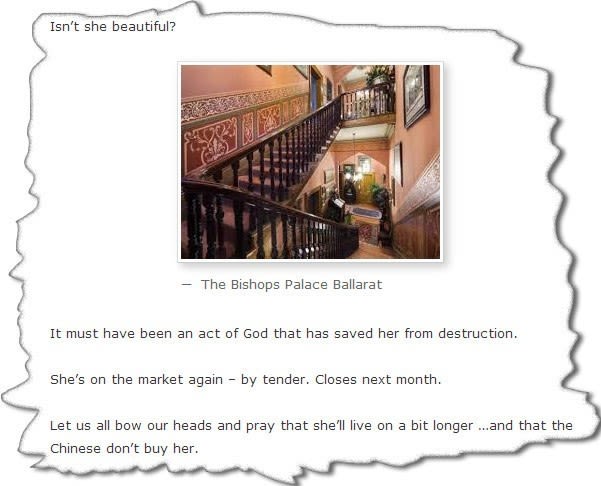Need for catholic outlook when it comes to Ballarat's Bishops Palace buyers
It was quite affronting when the property blogger Prue Miller suggested last year that Chinese buyers should not buy Ballarat's Bishops Palace.
The home of the first bishop of Ballarat Diocese at 1444 Sturt Street in Ballarat is a heritage-listed property, set on a 14,500 square metre holding.
It was built in 1873 as the headquarters for the Ballarat Diocese and its first bishop, Dr Michael O’Connor to a design by Melbourne architect Joseph Reed of Reed and Barnes at a cost of £6,000.
Its most recent price guidance was $5.5 million plus through PRDnationwide agent Neil Jens with 1444 Sturt Street having been initially listed at $6.5 million. But this week ads have appeared for its February 21, 2014 expressions of interest marketing campaign suggesting $4.5 million plus buyer interest. Jens tells Property Observer all the buying interest had come from intending home buyers. Prestige sales have tended to be on Lake Wendouree where $2,825,000 was paid in late 2007 for a house with 53 square metres of living space, an indoor pool and a tennis court on a large block.
The median house price in Ballarat is $315,000. It was last sold for around $700,000 in 1996 by the Catholic Church, and remains in mint condition.
"Isn’t she beautiful,” Miller wrote on her personal blog, real-estate-writer.com.
Prue advised she has strong family connections to Ballarat and had been visiting the town her whole life.
She says it breaks her heart to see the heritage of the town slip away, “wilfully destroyed by a series of inept, thoughtless, gutless councillors”.

Photo: Screenshot of real-estate-writer.com.
There was a similiar undercurrent in the community when Fortuna Villa at Bendigo was sold mid-last year for $3 million reputedly to Chinese interests.
On this Australia Day weekend let us not forget that these regional cities rose to prominence during the Victorian gold-rush when thousands of fortune-seekers descended on goldfield towns - with a strong Chinese contingent.
By 1855 nearly 19,000 Chinese people had landed in Ballarat and by 1857 that had risen to 26,000. In 1858, the peak of the gold-rush period, 25% of men in Ballarat were Chinese.
The heavily taxed migrants were forced to live in Chinese-only camps and were the subject of unfair regulations. Despite this they raised funds for a number of public institutions such as Ballarat’s public library, orphanage and hospital.
Little remains of Ballarat’s rich Chinese heritage. One of the last vestiges, the Chinese temple, was destroyed in the 1960s after being derelict for a number of years. Visitors can, however, still take a tour of the Chinese section of the local cemetery.
There's a need for a catholic outlook among the commentariat when it comes to Ballarat's Bishops Palace buyers.
Our historical properties should be living reminders of all our pasts - with ownership for anyone who wishes to make them vibrant.